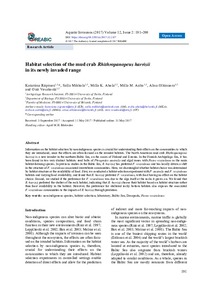Habitat selection of the mud crab Rhithropanopeus harrisii in its newly invaded range
Milla M. Aalto; Alisa Olkinuora; Katariina Riipinen; Outi Vesakoski; Milla K. Ahola; Salla Mikkola
https://urn.fi/URN:NBN:fi-fe2021042716813
Tiivistelmä
Information on the habitat selection by non-indigenous species is crucial for understanding their effects on the communities to which they are introduced, since the effects are often focused on the invaded habitats. The North American mud crab Rhithropanopeus harrisii is a new invader in the northern Baltic Sea, on the coasts of Finland and Estonia. In the Finnish Archipelago Sea, it has been found in two very distinct habitats: reed belts of Phragmites australis and algal zones with Fucus vesiculosus as the main habitat-forming species. In previous studies in the Baltic Sea, R. harrisii has preferred F. vesiculosus and has locally driven a shift in the structure of F. vesiculosus-associated invertebrate communities. Here, we disentangled whether habitat choice was determined by habitat structure or the availability of food. First, we conducted a habitat selection experiment with P. australis and F. vesiculosus habitats and varying food availability, and found that R. harrisii preferred F. vesiculosus, with food having no effect on the habitat choice. Second, we studied if the preference for F. vesiculosus was due to the alga itself or the rocks it grows on. We found that
R. harrisii preferred the shelter of the rock habitat, indicating that R. harrisii choose their habitat based on habitat structure rather than food availability in the habitat. However, the preference for sheltered rocky bottom habitats also exposes the associated F. vesiculosus communities to the impacts of R. harrisii through predation.
Kokoelmat
- Rinnakkaistallenteet [19207]
